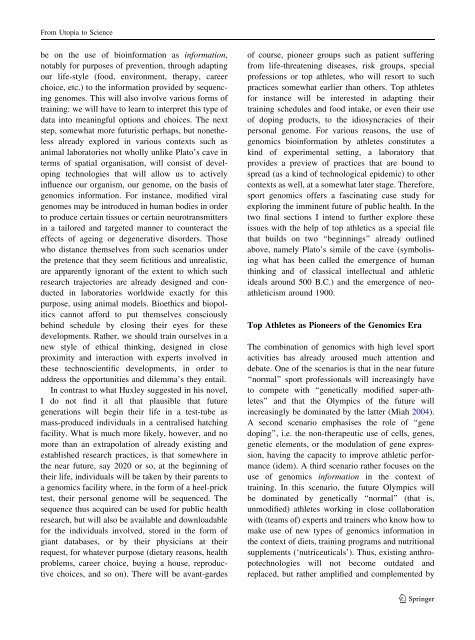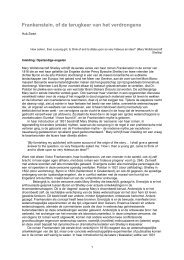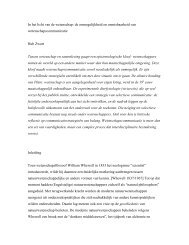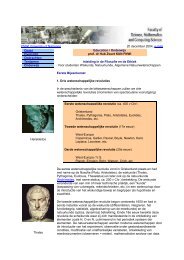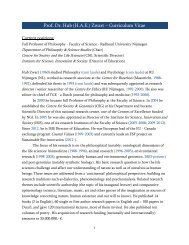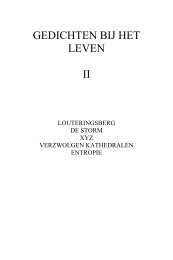Download - Hub Zwart
Download - Hub Zwart
Download - Hub Zwart
- No tags were found...
Create successful ePaper yourself
Turn your PDF publications into a flip-book with our unique Google optimized e-Paper software.
From Utopia to Sciencebe on the use of bioinformation as information,notably for purposes of prevention, through adaptingour life-style (food, environment, therapy, careerchoice, etc.) to the information provided by sequencinggenomes. This will also involve various forms oftraining: we will have to learn to interpret this type ofdata into meaningful options and choices. The nextstep, somewhat more futuristic perhaps, but nonethelessalready explored in various contexts such asanimal laboratories not wholly unlike Plato’s cave interms of spatial organisation, will consist of developingtechnologies that will allow us to activelyinfluence our organism, our genome, on the basis ofgenomics information. For instance, modified viralgenomes may be introduced in human bodies in orderto produce certain tissues or certain neurotransmittersin a tailored and targeted manner to counteract theeffects of ageing or degenerative disorders. Thosewho distance themselves from such scenarios underthe pretence that they seem fictitious and unrealistic,are apparently ignorant of the extent to which suchresearch trajectories are already designed and conductedin laboratories worldwide exactly for thispurpose, using animal models. Bioethics and biopoliticscannot afford to put themselves consciouslybehind schedule by closing their eyes for thesedevelopments. Rather, we should train ourselves in anew style of ethical thinking, designed in closeproximity and interaction with experts involved inthese technoscientific developments, in order toaddress the opportunities and dilemma’s they entail.In contrast to what Huxley suggested in his novel,I do not find it all that plausible that futuregenerations will begin their life in a test-tube asmass-produced individuals in a centralised hatchingfacility. What is much more likely, however, and nomore than an extrapolation of already existing andestablished research practices, is that somewhere inthe near future, say 2020 or so, at the beginning oftheir life, individuals will be taken by their parents toa genomics facility where, in the form of a heel-pricktest, their personal genome will be sequenced. Thesequence thus acquired can be used for public healthresearch, but will also be available and downloadablefor the individuals involved, stored in the form ofgiant databases, or by their physicians at theirrequest, for whatever purpose (dietary reasons, healthproblems, career choice, buying a house, reproductivechoices, and so on). There will be avant-gardesof course, pioneer groups such as patient sufferingfrom life-threatening diseases, risk groups, specialprofessions or top athletes, who will resort to suchpractices somewhat earlier than others. Top athletesfor instance will be interested in adapting theirtraining schedules and food intake, or even their useof doping products, to the idiosyncracies of theirpersonal genome. For various reasons, the use ofgenomics bioinformation by athletes constitutes akind of experimental setting, a laboratory thatprovides a preview of practices that are bound tospread (as a kind of technological epidemic) to othercontexts as well, at a somewhat later stage. Therefore,sport genomics offers a fascinating case study forexploring the imminent future of public health. In thetwo final sections I intend to further explore theseissues with the help of top athletics as a special filethat builds on two ‘‘beginnings’’ already outlinedabove, namely Plato’s simile of the cave (symbolisingwhat has been called the emergence of humanthinking and of classical intellectual and athleticideals around 500 B.C.) and the emergence of neoathleticismaround 1900.Top Athletes as Pioneers of the Genomics EraThe combination of genomics with high level sportactivities has already aroused much attention anddebate. One of the scenarios is that in the near future‘‘normal’’ sport professionals will increasingly haveto compete with ‘‘genetically modified super-athletes’’and that the Olympics of the future willincreasingly be dominated by the latter (Miah 2004).A second scenario emphasises the role of ‘‘genedoping’’, i.e. the non-therapeutic use of cells, genes,genetic elements, or the modulation of gene expression,having the capacity to improve athletic performance(idem). A third scenario rather focuses on theuse of genomics information in the context oftraining. In this scenario, the future Olympics willbe dominated by genetically ‘‘normal’’ (that is,unmodified) athletes working in close collaborationwith (teams of) experts and trainers who know how tomake use of new types of genomics information inthe context of diets, training programs and nutritionalsupplements (‘nutriceuticals’). Thus, existing anthropotechnologieswill not become outdated andreplaced, but rather amplified and complemented by123


